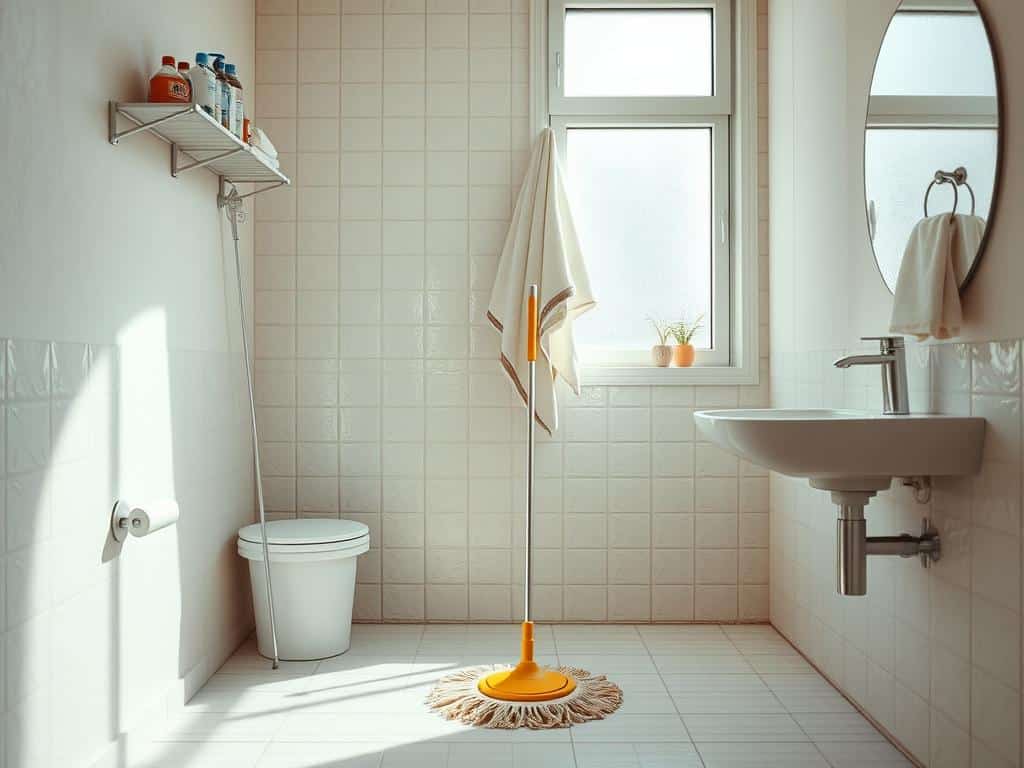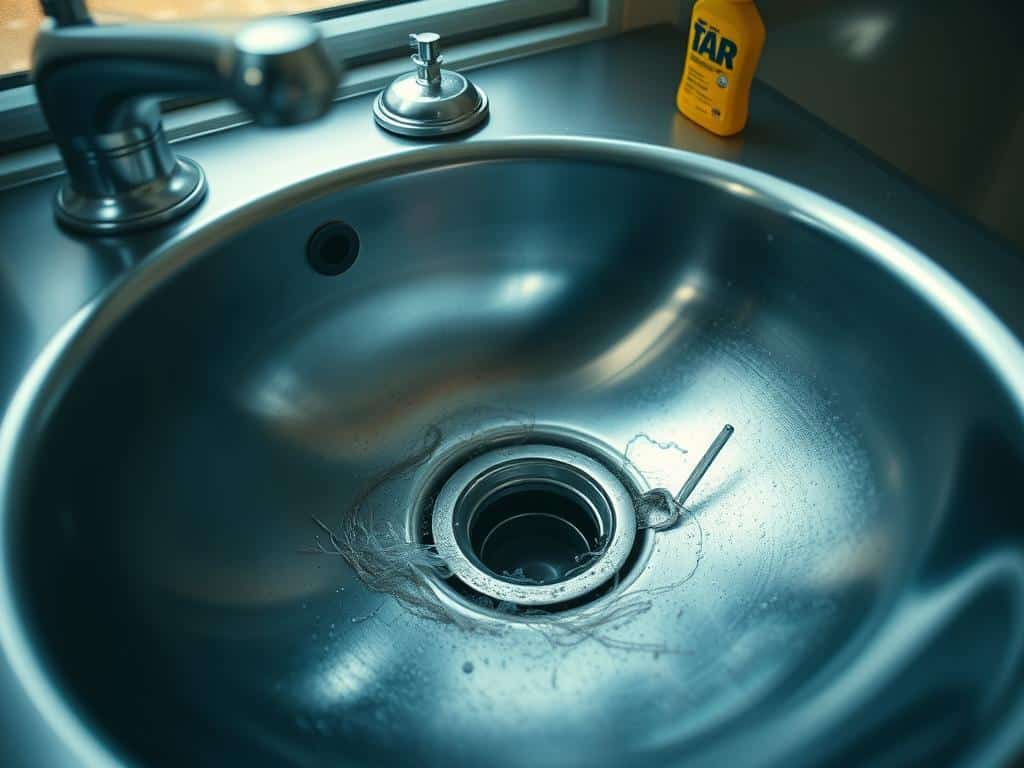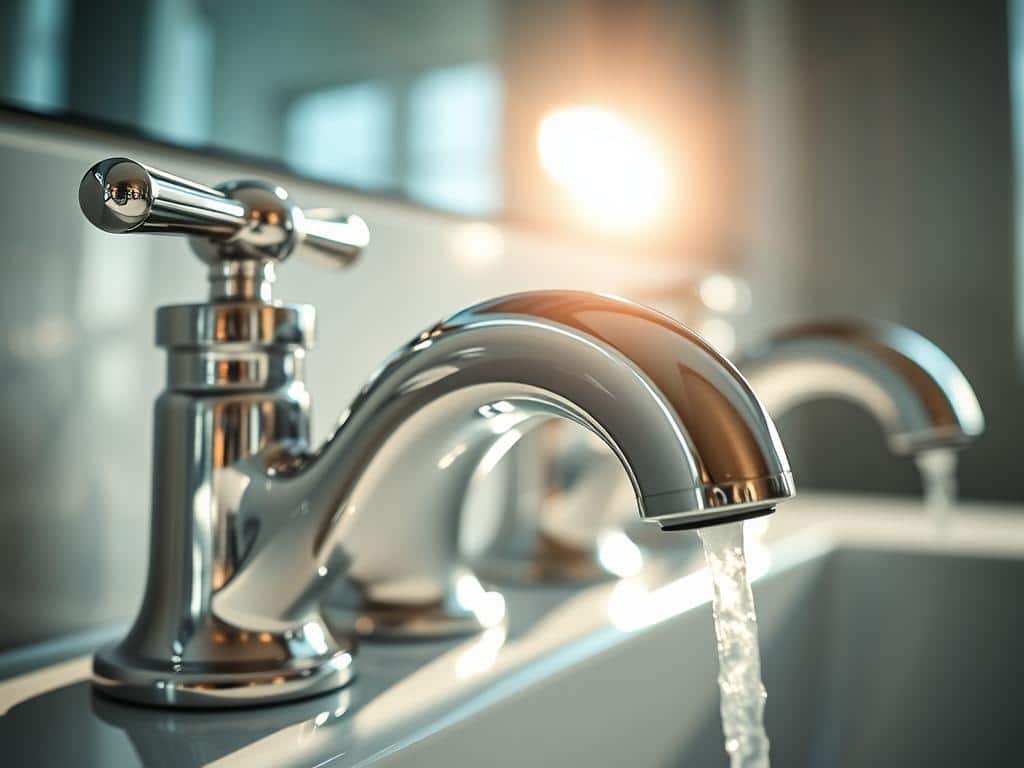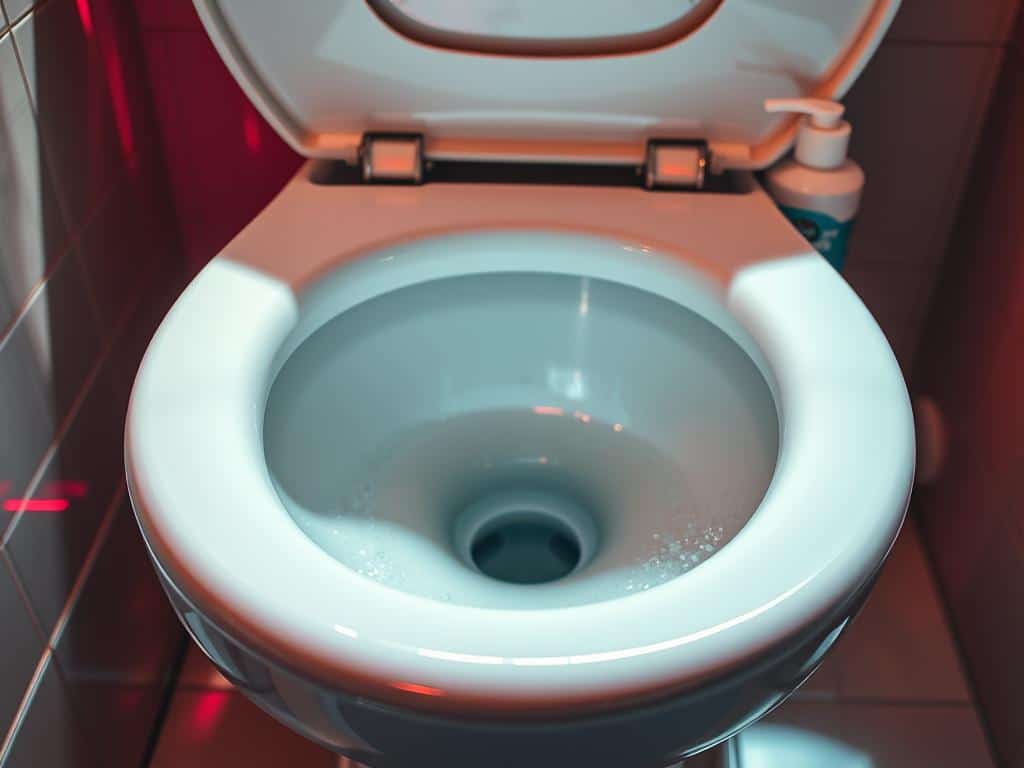
Cleaning your toilet is crucial for a clean bathroom. However, toilet bowl rings can be tough to remove. These stains often come from minerals in the water, mainly in areas with hard water. The stains might look brown or green from minerals, or even pink or orange from bacteria. This guide offers easy and effective ways to get rid of toilet bowl stains. You’ll learn about various cleaning hacks. We’ll cover natural solutions like vinegar and baking soda. Also, mild abrasive cleaners like Bon Ami, Bar Keepers Friend, and The Pink Stuff are mentioned.
Using these simple toilet bowl cleaning tips, your bathroom will stay clean. No more annoying rings. This article explains the causes and shows DIY cleaning methods. With these tips and knowledge, keeping your toilet spotless is easy. Discover the best cleaning methods to tackle stubborn stains in your toilet bowl.
Understanding the Causes of Toilet Bowl Rings
Toilet bowl rings don’t always mean your cleaning is lacking. They come from things in your home environment. Understanding why they happen is the first step in fighting them off.
Common Culprits
Two main things cause toilet bowl rings: minerals and bacteria. Knowing these causes helps you clean better and more effectively.
Mineral Deposits
If you have hard water, you’re more likely to see *toilet bowl stains*. *Hard water stains* are from minerals like calcium and iron. They make brown or green marks that are hard to remove.
Regular cleaning and maybe a water softener can help a lot. It’s crucial to keep cleaning regularly to prevent these stains.
Bacterial Formation
A type of bacteria called *Serratia marcescens* causes pink or orange rings. It loves wet places, so your toilet is perfect for it. By cleaning often, you can stop this bacteria from growing.
Knowing that minerals and bacteria both cause these stains helps you prevent them better.
| Factors | Examples | Prevention Tips |
|---|---|---|
| Mineral Deposits | Calcium, Iron, Lime, Magnesium | Install a water softener, consistent cleaning |
| Bacterial Formation | Serratia marcescens bacteria | Ensure regular cleaning, maintain dryness |
| Bathroom Cleaning Routine | Primary bathroom: once a week, Secondary bathroom: every other week | Set a cleaning schedule, use appropriate products |
DIY Methods to Remove Toilet Bowl Rings
Homemade toilet cleaning solutions are both powerful and kind to the environment. We will look at DIY methods that save money and are great at removing tough stains.
Using White Vinegar and Baking Soda
A favorite method for natural cleaning involves white vinegar and baking soda. Mix equal parts of these directly in the bowl. When they meet, they fizz, breaking down the build-up and stains.
Leave it to work for 15 minutes. Then, gently scrub with a brush. This method doesn’t require hard scrubbing.
Employing Mild Abrasives
If vinegar and baking soda don’t do the trick, try mild abrasives. Use Bon Ami or Bar Keepers Friend on tough spots. These products are safe for your toilet and effective.
Utilizing a Pumice Stone
For the toughest stains, a pumice stone works well. It’s great for rust or scale. But, make sure the surface is wet to avoid scratches. This is a good step up when you need more scrubbing power.
Here’s a quick comparison table of the methods we’ve talked about:
| Method | Materials Needed | Effectiveness |
|---|---|---|
| White Vinegar and Baking Soda | White vinegar, baking soda | Effective for mild to moderate stains |
| Mild Abrasives | Bon Ami, Bar Keepers Friend | Great for hard water stains |
| Pumice Stone | Pumice stone, water | Highly effective for stubborn stains |
Effective Commercial Cleaners
Some commercial toilet bowl cleaners are really good at cleaning. They work well for rust, mineral deposits, and germs. These products make cleaning easier and more effective.
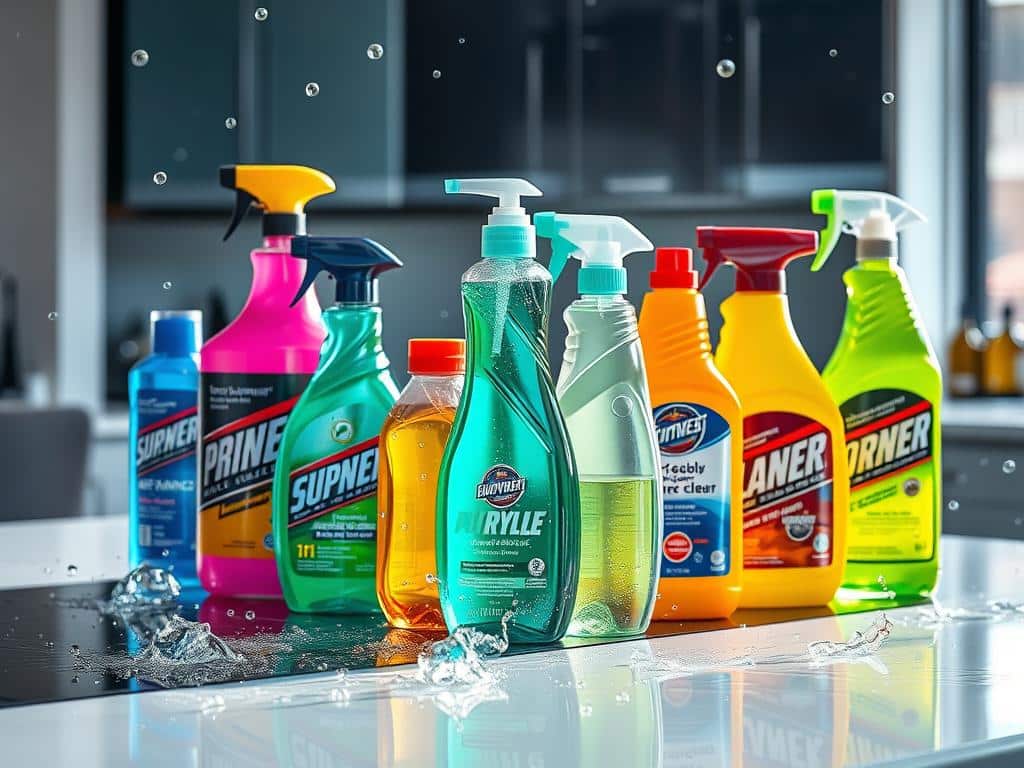
Bon Ami
Bon Ami comes in a powder form. It’s perfect for making a paste for scrubbing. This paste is great for getting rid of rust and mineral deposits.
Bon Ami cleans without scratching your toilet. It’s both gentle and strong.
Bar Keepers Friend
Bar Keepers Friend is similar to Bon Ami. It’s a top choice for cleaning toilets. It removes rust, mineral deposits, and hard water stains effectively.
It’s a reliable cleaner keeping toilets clean and shiny.
The Pink Stuff
The Pink Stuff is a cream cleaner. It’s easy to apply directly to wet areas. It’s excellent at removing tough stains, even bacteria like Serratia marcescens.
It’s handy for a clean, germ-free toilet.
For detailed cleaning tips, check out the expert advice from Squeaky Cleaner’s guide.
Quick and Easy Steps: How to Clean a Toilet Bowl Ring
Starting a toilet cleaning process needs the right stuff. Here’s how to get rid of a toilet bowl ring effectively:
Materials Needed
Make sure you have these before beginning:
- White vinegar
- Baking soda
- Pumice stone
- Toilet brush
- Gloves
Step-by-Step Guide
- Apply Vinegar: First, pour a cup of white vinegar inside the toilet bowl. This loosens mineral deposits.
- Add Baking Soda: Next, scatter baking soda inside. Make sure it’s even. Then, add 1-2 cups of vinegar. This mix will bubble up and start loosening the stains.
- Wait and Scrub: Let it sit for about an hour. The mix helps remove tough stains. After waiting, use a brush to scrub well.
- Use a Pumice Stone: For hard stains, like a tough ring, gently use a pumice stone on them. But, be gentle to avoid damaging the porcelain.
- Rinse and Flush: After cleaning, flush to wash away cleaners. If some residue stays, scrub it one more time.
This thorough method helps you fight and stop toilet bowl rings. And if you’re into natural options, there’s more to try than just vinegar.
Preventing Future Toilet Bowl Rings
Keeping your toilet clean is key to preventing future toilet bowl rings. In places with hard water, regular cleaning is especially important. It helps your toilet stay clean and work well.
Cleaning your bathroom weekly is what experts suggest. It keeps your toilet free from germs. It also stops the buildup that causes those rings. Using gentle detergents, white vinegar, or baking soda is wise. For instance, putting vinegar in the bowl and letting it sit works wonders.
In places with hard water, getting a water softener is a smart move. Texas, Arizona, Nevada, Indiana, and Florida have very hard water. This makes toilet rings more common. A water softener cuts down on minerals, keeping stains away and pipes in good shape.
Adding smart cleaning tips to your routine is a good idea. Every so often, clean deeply with special products. Using cleaners like Seventh Generation Toilet Bowl Cleaner fights stains well. Choose mild abrasives and the right tools, like a silicone brush, for safe cleaning.
Following these toilet maintenance hacks is important. Avoid rough brushes and the wrong use of bleach. You’ll need baking soda, white vinegar, and a pumice stone for cleaning. Don’t forget rubber gloves for safety.
Not cleaning regularly leads to hard-to-remove rings. Hiring a pro to install a water softener makes cleaning easier. It stops mineral buildup before it starts.
Conclusion
Keeping your toilet clean is key to good bathroom hygiene. It helps if you know why toilet bowl rings form. This includes things like mineral buildup and bacteria growth. We have several methods to clean these, including home remedies and store-bought products. You could use white vinegar and baking soda or cleaners like Bon Ami and Bar Keepers Friend.
For tough cases, like stubborn rings caused by hard water, a Pumie Stick works well. Many people share their success stories online, praising its effectiveness. This non-toxic cleaner helps achieve a spotless toilet quickly. Combined with simple cleaning tips, you’ll end up with a cleaner and more welcoming bathroom.
To stop these problems from returning, it’s smart to follow certain prevention techniques. Adding these tips to your cleaning routine makes for an easier job. For more on keeping your bathroom clean, check out online forums and social media. There’s a great discussion on toilet cleaning here.

